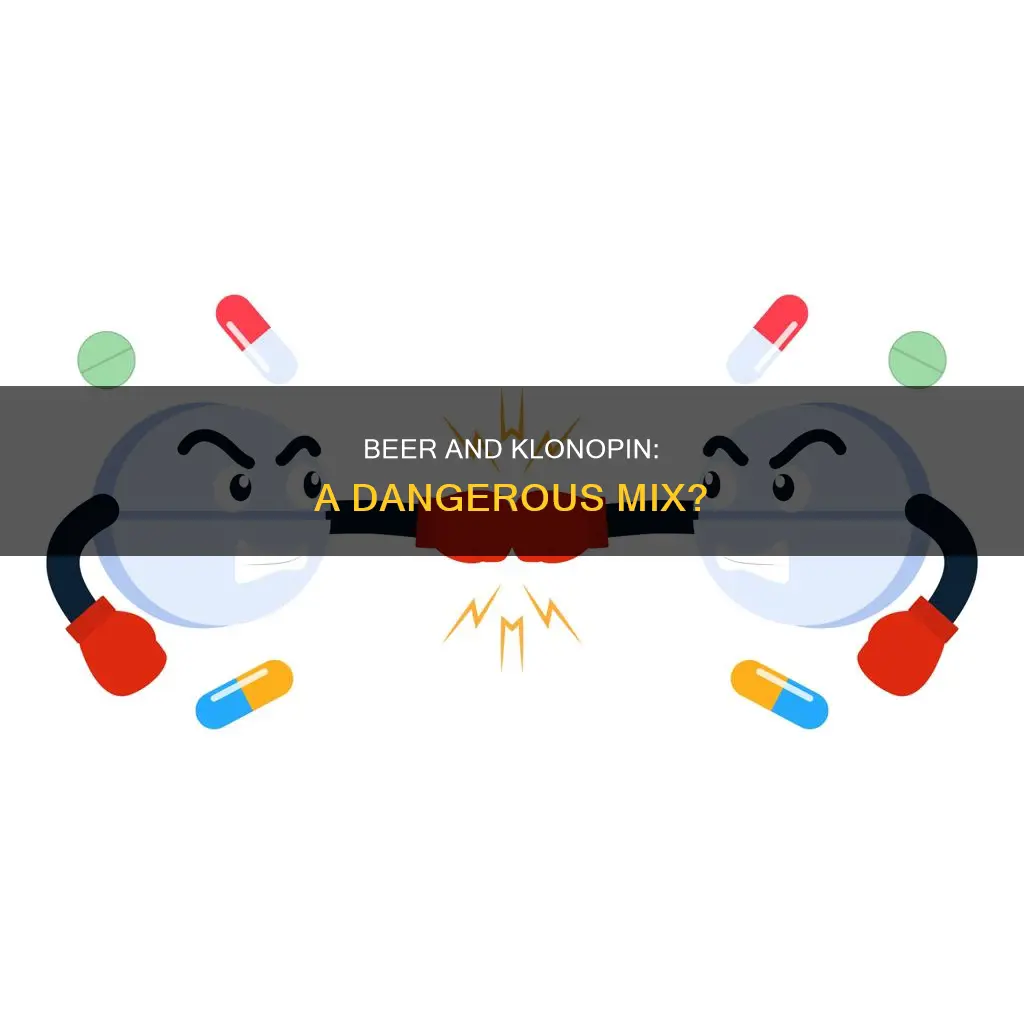
Mixing Klonopin and alcohol can lead to dangerous side effects and health complications, including overdose and even death. Both substances are central nervous system depressants, which slow down the activity of the brain. When taken together, the effects of both substances are intensified, increasing the risk of severe respiratory and cardiac problems, such as slowed breathing and heart rate, as well as loss of consciousness and coordination. Klonopin is a highly addictive controlled substance, and its effects are heightened when combined with alcohol, increasing the likelihood of addiction and accidental overdose.
| Characteristics | Values |
|---|---|
| Mixing Klonopin and alcohol | Dangerous |
| Klonopin | Benzodiazepine, central nervous system depressant |
| Alcohol | Central nervous system depressant |
| Mixing Klonopin and alcohol | Increases health risks |
| Klonopin | Highly addictive |
| Alcohol | Highly addictive |
| Mixing Klonopin and alcohol | Increases effects of both substances |
| Mixing Klonopin and alcohol | Increases risk of overdose |
| Mixing Klonopin and alcohol | Increases risk of injury and death |
| Mixing Klonopin and alcohol | Enhances negative side effects |
| Klonopin side effects | Memory problems, coordination problems, seizures |
| Alcohol side effects | Loss of coordination, weak and sluggish behaviour |
What You'll Learn

Klonopin and alcohol are central nervous system depressants
Klonopin (clonazepam) is a benzodiazepine medication that is often prescribed to treat seizures, panic attacks, and anxiety. It is a central nervous system depressant, which means it slows down brain activity. While Klonopin can be beneficial for these conditions, it also has sedative effects and can be addictive.
Alcohol is also a central nervous system depressant. When Klonopin and alcohol are mixed, the depressive effects of both substances are enhanced, leading to more pronounced side effects. This intensification can be extremely dangerous and even deadly.
The combination of Klonopin and alcohol can result in severe drowsiness, dizziness, and impaired cognitive function. It also significantly slows down breathing and heart rate, increasing the risk of respiratory depression, cardiac complications, and even death. The risk of accidental overdose is also heightened when these substances are mixed.
In addition, mixing Klonopin and alcohol can strain the liver, as both substances are metabolized by this organ. This can lead to reduced liver function and an increased risk of liver damage and disease.
The dangers of combining Klonopin and alcohol are well-known, and it is strongly advised to avoid mixing these substances. The enhanced effects of the drugs can be life-threatening, and seeking immediate medical attention is crucial if any severe side effects are observed.
Old Beer: Is It Safe to Drink After Years?
You may want to see also

Mixing the two can lead to overdose and death
Mixing Klonopin and alcohol can lead to dangerous side effects and health complications. Klonopin is a benzodiazepine commonly prescribed to treat panic disorders, compulsive disorders, depression, and psychological disorders. It is a central nervous system depressant, which means it slows down the activity of the brain. When mixed with alcohol, another central nervous system depressant, the effects of Klonopin are enhanced, leading to more pronounced side effects.
One of the most significant dangers of mixing Klonopin and alcohol is the increased risk of overdose. Since both substances influence the GABA receptors in the brain, their effects are multiplied when combined. This means that it takes a smaller amount of each substance to reach toxic levels in the body, increasing the likelihood of an accidental and fatal overdose. The combination of Klonopin and alcohol can also lead to blackouts, during which there is a risk of unintended consumption of more Klonopin, further raising the risk of overdose.
Signs of a Klonopin overdose include loss of motor skills and bodily coordination, disorientation, and confusion. If you suspect someone has overdosed, it is crucial to call emergency services immediately. While waiting for help, keep the person awake and breathing if possible, and lay them on their side to prevent choking if they vomit.
The combination of Klonopin and alcohol can also lead to other dangerous side effects, including severe respiratory depression, slowed heart rate, memory problems, seizures, and loss of consciousness. These side effects can be life-threatening and require immediate medical attention.
In conclusion, mixing Klonopin and alcohol can lead to overdose and death due to the enhanced effects of both substances on the central nervous system. It is crucial to refrain from drinking alcohol while taking Klonopin to avoid these dangerous consequences.
Beer Tube Screens: How Do They Work?
You may want to see also

Side effects include slowed breathing and heart rate
Mixing Klonopin and alcohol can lead to a series of dangerous side effects. Both Klonopin and alcohol are central nervous system depressants, which slow down the activity of the brain. When taken together, these effects are amplified and can even be deadly.
Klonopin, also known by its generic name clonazepam, is a prescription drug commonly used to manage panic, anxiety, and seizure disorders. It is part of the benzodiazepine class of drugs, which includes Valium, Xanax, Ativan, and Restoril. As a central nervous system depressant, Klonopin slows down certain processes in the body and mind, such as respiration rate and heart rate. This is due to its ability to amplify the effects of gamma-amino butyric acid (GABA), a neurotransmitter in the brain that decreases neural excitation. As a result, Klonopin can decrease anxiety levels and induce a sense of calm and relaxation in the user.
However, when Klonopin is combined with alcohol, the depressive attributes of both substances are enhanced. This leads to a significant slowing of the heart rate and breathing rate, which can be life-threatening. Depressed breathing means that the individual cannot get enough oxygen, and if they become unresponsive with blue lips or fingers, they require immediate medical attention.
The combination of Klonopin and alcohol also increases the risk of other serious side effects, including overdose, hospitalization, serious injury, and even death. According to a 2014 study, 32% of all ER visits for benzodiazepines like Klonopin resulted in serious outcomes, including permanent disability and overdose deaths. Therefore, it is strongly recommended that individuals taking Klonopin refrain from consuming alcohol to avoid these potentially fatal consequences.
Beer before work: Is it illegal or not?
You may want to see also

Klonopin is addictive and enhances alcohol's effects
Klonopin, or clonazepam, is a highly addictive prescription medication. It is a benzodiazepine, which means it is a central nervous system depressant, slowing down activity in the brain. This is beneficial for treating disorders such as seizures and panic disorders, but it can also be addictive.
Klonopin is often prescribed to treat anxiety, and it is highly effective at eliminating extreme feelings of fear and worry. It gives patients a sense of calm and relaxation, which can become addictive. The body can rapidly develop a tolerance to and dependence on Klonopin, and it should only be taken as prescribed and for no longer than two weeks.
Klonopin is also similar to alcohol in that alcohol is also a central nervous system depressant. Both Klonopin and alcohol increase drowsiness and depress breathing and heart rate. When combined, these effects are intensified, which can be extremely dangerous. Even small doses of each can lead to a lack of coordination and drowsiness, increasing the risk of a fall or serious injury.
The combination of Klonopin and alcohol also increases the risk of overdose, hospitalization, and death. According to a 2014 SAMHSA study, 44% of all surveyed emergency room visits involving benzodiazepines also involved mixing the drug with alcohol. Klonopin enhances alcohol's effects, so if you drink, you will not be able to drink as much as you used to.
Due to the addictive nature of Klonopin and its dangerous interaction with alcohol, it is important not to mix the two substances, even if you have a legitimate prescription.
The Science of Nitro Beers: How Do They Work?
You may want to see also

Treatment is available for Klonopin and alcohol addiction
Mixing Klonopin and alcohol is highly dangerous and can lead to overdose and even death. Both Klonopin and alcohol are central nervous system depressants, which slow down brain activity. When taken together, the effects of both substances are intensified, leading to enhanced drowsiness, impaired coordination, and difficulty breathing. Mixing Klonopin and alcohol can also cause memory problems and increase the risk of accidents and injuries.
If you or someone you know is struggling with Klonopin and alcohol addiction, it is important to seek professional help. Treatment for Klonopin and alcohol misuse typically involves a combination of medical detoxification, counseling, and therapy. Here are some steps and options for treatment:
Medical Detoxification
Medical detox is a crucial first step in the treatment process. It involves gradually reducing the dosage of Klonopin under the supervision of a healthcare professional. This process helps to reduce the severity of withdrawal symptoms, which may include anxiety, mood changes, sleep disturbances, and psychological effects such as mood swings, irritability, anhedonia, and depression. Detoxification should always be conducted under medical supervision, as self-managed alcohol detox can be dangerous and lead to complications.
Rehabilitation
Rehabilitation is a multifaceted process that addresses both the physical and psychological dependencies created by Klonopin and alcohol. It involves behavioral therapy, counseling, and long-term support mechanisms to prevent relapse and promote a healthy, substance-free lifestyle. Cognitive-behavioral therapy (CBT) is commonly used to help individuals identify and change negative thought patterns that contribute to substance use.
Support Groups and Aftercare
After completing a formal treatment program, individuals are encouraged to participate in aftercare programs, which may include continued therapy, support groups, and other services aimed at sustaining recovery and preventing relapse. Active engagement in aftercare programs has been shown to significantly contribute to successful long-term recovery from Klonopin and alcohol misuse.
Preventive Strategies and Education
In addition to treatment, prevention and education are critical components in the fight against Klonopin and alcohol misuse. This includes public awareness campaigns, early intervention, and community-based initiatives to reduce substance misuse. Education on the dangers of mixing alcohol with medications like Klonopin is essential for preventing hazardous outcomes.
If you or a loved one are struggling with Klonopin and alcohol addiction, reach out to a trained drug abuse counselor or a recovery advocate to get the help you need. There are also national helplines, such as SAMHSA's National Helpline in the United States, that offer free and confidential treatment referral and information services.
The Magical Math of 79 Beers: Age Subtraction Mystery
You may want to see also
Frequently asked questions
Klonopin is a benzodiazepine commonly prescribed to treat panic disorders, seizures, and compulsive disorders. It is a central nervous system depressant that slows down the brain's activity.
Mixing Klonopin and alcohol can lead to dangerous side effects and health complications. Both substances are central nervous system depressants, and when combined, they can cause slowed breathing and heart rate, loss of coordination, memory loss, and increased risk of overdose and other serious side effects.
Mixing Klonopin and alcohol can be dangerous and lead to severe health risks. It is recommended to seek professional help and treatment options, such as detoxification and psychological counseling, to address the potential addiction and health complications.







